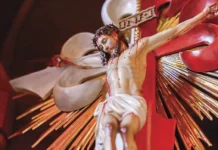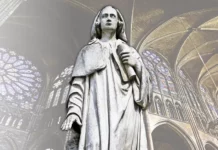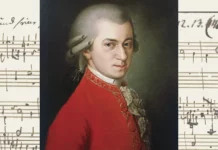Victoria’s talent is most evident at the foot of the Saviours’ Cross. Listening to his music, Our Lord Jesus Christ seems to say to us: “My child, I have suffered so much for you! Will you not suffer a little for Me?”
Who is not moved to contemplate Him who went about on earth doing good (cf. Acts 10:38), being the object of more hatred, scorn and outrages than has any man ever been in history? For today’s generations, so accustomed to a life aimed at avoiding suffering, it would perhaps cause terror to see the condition of the God-Man on His way to Calvary!
After enduring the ingratitude of one whom He had loved as a son and had chosen as an Apostle, He spent the night in vigil, subjected to tribunals, receiving blows and insults, abandoned by His own. And as if this were not enough, the next morning, tied to a pillar, He was cruelly scourged before carrying the Cross to the height of Golgotha.
Exhausted and agonizing, Our Lord Jesus Christ implored the men of all times: “O all ye that pass by the way, attend, and see if there be any sorrow like to my sorrow” (Lam 1:12). How many have remained indifferent to His love! How many have rejected His sacrifice and refused the Heaven that He opened with His death! How many have perpetuated throughout history the ingratitude of those who stood at the foot of the Cross, sacrilegiously trampling on the Blood that would bring them salvation!
And yet, how many heroes of the Faith have not hesitated to exclaim with St. Paul: “But far be it from me to glory except in the Cross of our Lord Jesus Christ, by which the world has been crucified to me, and I to the world” (Gal 6:14). These people fill the firmament of the Holy Church, illuminating it with their brilliance!
As we contemplate these luminous stars, our eyes fall upon one whose light has continued to shine through the centuries in a very unique way. Even today, among musicians of sacred polyphony, his name is pronounced with admiration and respect; and among the faithful who are friends of the cross and of tradition, his melodies produce the most precious fruits of piety.

Born in 1548, Tómas Luis de Victoria’s birthplace was, like St. Teresa of Jesus, the Spanish city of Avila. At that time, great changes were taking place in the social panorama, encompassing all areas of human life.
The Spanish Golden Age
In the long-distant 16th century, Spain had reached a new turning point in its history. After eight hundred years of struggle to regain its lands, finally – with the fall of the Muslim kingdom of Granada in 1492 – the last enemy stronghold had been subjugated. And, immediately afterwards, an entirely unexpected horizon opened before its eyes: America!
On another level, while in the rest of Europe Christendom was being rent in two by Protestantism, Spain was launching itself wholeheartedly into the Counter-Reformation and the conquest of new continents for the Church.
It was then that Providence, perhaps as a reward for keeping the torch of fidelity to the Faith burning, favoured the political, economic and even artistic growth of this Iberian nation. Spanish became a language spoken throughout the whole world. Its galleons traversed the Atlantic and the Pacific. In the field of literature, science and the arts, the Spanish Golden Age was blossoming.
In this glorious era of its history, “Spain undoubtedly took the lead, together with Italy, [in the various branches of art], producing in all areas works of great artistic value, which constitute one of the best reflections of the Catholic spirit of the Peninsula.”1
At the dawn of a new artistic expression
Music also reached its apogee during the Golden Age, in which shone, along with Victoria, Francisco Guerrero, Cristóbal de Morales and other masters. However, it was the composer from Avila who brought forth its most brilliant expression.
His work fits into the transition between Renaissance polyphony and baroque expressionism, but is characterized, above all, by its inspiration in the fervour of the Counter-Reformation.
Impelled by this spirit, “all the arts were placed at the service of the Catholic Church, and it was obvious and natural for the Church to manifest the profound renewal it had experienced in the exuberance of its great religious buildings and in the splendour of painting, sculpture and all the decorative arts.
“This vivid exuberance in worship and art coincides with the beginning of baroque, which is why it is the opinion of some that this style is the most appropriate expression of the Catholic Reformation of the late 16th and 17th centuries.”2
In fact, baroque art flourished above all in those European nations that had preserved the Faith in its entirety, such as Spain, Portugal and Italy. And if the Renaissance preached the predominance of reason, there is in the new artistic style an exaltation of the sentiments that enable an intense expression of religiosity.
Talent united with piety
It was at this juncture that Tomás Luis de Victoria fulfilled his artistic and evangelizing mission.
As a child, he had his first encounter with music as a member of the Avila Cathedral choir. This period of his life passed in simplicity, and little is known of it. Some years later, under the patronage of the monarch, Philip II, he went to Rome, where he could deepen his musical knowledge and, above all, prepare himself to ascend to the most glorious and sacrificial state: that of the priesthood.
With this intention, Victoria enrolled in the Collegium Germanicum, founded by the Jesuits, where he encountered the saviour of sacred polyphony: Giovanni Pierluigi da Palestrina. He took some lessons with him and even succeeded him as chapel master in the Roman Seminary. The influence of Palestrina is perceptible in his first compositions, but afterwards a profound difference will mark the course and the musical sentiment of the two composers.
In 1575, Victoria was ordained a priest and entered the Congregation of the Oratory a few years later, becoming a disciple of St. Philip Neri. He returned to Spain in 1587, and assumed the chaplaincy of the Royal Convent of the Discalced Carmelites, in Madrid. In this capacity, he directly served the Empress Maria, widow of Maximilian II of Germany and sister of Philip II, who had retired to this community.

The work of Tomás Luis de Victoria, if compared to that of Palestrina or Orlando di Lasso – both of whom dominated the music of the 16th century along with him – is not very extensive. Nevertheless, he has the merit of never having employed his time and talent in profane compositions.
What shines in his music, even more than his artistic genius – which is also very notable – is his profound piety, free of Renaissance atheism and baroque superficiality. His work “consists of twenty Masses, forty-four motets, thirty-four hymns, various Magnificats and responsories, and above all the Officium Hebdomadæ Sanctæ,”3 a monumental collection for all of the Holy Week celebrations.

“His deep and sincere religious convictions give a special character to his pieces, of great technical purity, intense dramatic quality and passionate expression, which some authors have not hesitated to compare with what is transmitted by the poems of his contemporaries St. Theresa of Jesus and St. John of the Cross.”4
The Cross: his greatest inspiration
It is unfortunate that these lines are not capable of transmitting his melodies, enveloped by an imponderable of gravity and mystery, compassion and grace.
Victoria sings at Christmas, maintaining all the joy proper to that season. He knows how to highlight the magnificence of the mystery of the Incarnation – so often forgotten in the superficiality of Christmas festivities – as can be noted in his famous O Magnum Mysterium, considered by many to be an unrivalled achievement.
In his Requiem Mass, he recalls that death is not the end for a Christian, and he does not hesitate to further point out the joys of Heaven with an even cheerful tone, in the motet Gaudent in cœlis. He reproduces on earth the canticle of the Angels in Paradise, alternating in voices the choir of the Seraphim before the Most High, and he does not cease to praise the Mother of God in his compositions.
Nevertheless, it is at the Saviour’s Cross that Victoria’s talent best expresses his piety. In his Tenebrae Responsories, destined to accompany the Holy Week ceremonies, and in his innumerable motets of the Passion, the composer completely disappears, allowing the faithful to contemplate solely the wounds of Christ.
Who would dare to speak a word before a dying God? Victoria sought to console the Divine Redeemer with his music. And he speaks, more than he ever could with many words, to the innermost soul of all those who will hear his pieces until the end of the world, urging them to be serious and compassionate. By means of his compositions, Our Lord Jesus Christ seems to penetrate into the faithful soul and say: “My child, I have suffered so much for you! Will you not suffer a little for Me?”
Surely, from the height of the gibbet, the God-Man contemplated this son who would love His sorrows, would sympathize with His sufferings and sing the sacrality and grandeur of the Redemption for history and for eternity. And certainly this sight assuaged Him in His sufferings. ◊
Notes
1 GARCÍA VILLOSLADA, SJ, Ricardo; LLORCA, SJ, Bernardino. Historia de la Iglesia Católica: Edad Nueva. Madrid: BAC, 2005, v.III., p.958-959.
2 Idem, p.1069.
3 DELLA CORTE, A.; PANNAIN, G. Historia de la música. De la Edad Media al siglo XVIII. Barcelona: Labor, 1950, t.I, p.291.
4 RUIZA, M.; FERNANDÉZ, T.; TAMARO, E. Biografia de Tomás Luis de Victoria. In: www.biografiasyvidas.com.







